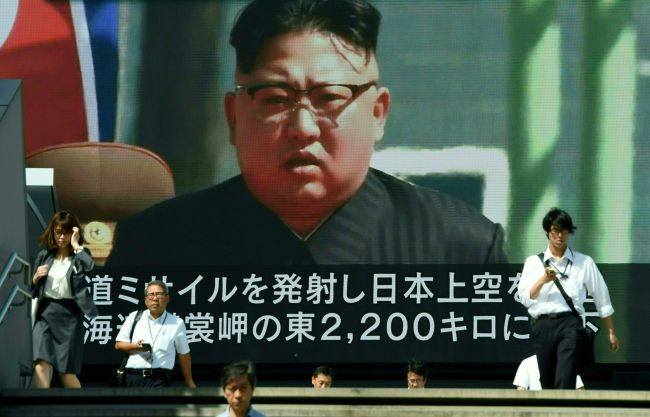Friday’s missile launch shows North Korea is closer to completing its decadeslong missile and nuclear weapons programs, and its leader Kim Jong-un has no real incentive to abandon them at this stage, experts said.
They also noted that the series of missile and nuclear tests may have been based on the regime’s calculated timeline and that the regime would not halt its endeavors until it can exert concessions from the US in a one-on-one negotiation.
Despite the United Nations’ new sanctions, the North on Friday fired another missile that flew over Japan. Earlier this month, it conducted its sixth and largest nuclear test and test-fired its first intercontinental ballistic missiles in July.
“North Korea is strongly convinced about what they are doing,” said Shin Won-sik, a retired three-star general who served as a top operational strategist at Seoul’s Joint Chiefs of Staff. “It will continuously step on the accelerator until it achieves the goal.”
 |
Pedestrians walk in front of a large video screen in Tokyo broadcasting a news report showing North Korean leader Kim Jong-un, following a North Korean missile test that passed over Japan on Friday. (AFP-Yonhap) |
The North’s continued show of defiance is ultimately designed to enhance its leverage in negotiation with the United States and exert concessions such as the US' recognition of it as a legitimate nuclear power and withdrawing US troops from South Korea, said Kim Yeon-chul, a professor at Inje University.
“The current accelerated pace of provocations can be understood in the context of North Korea’s belief that it can strike a deal with the US only after accomplishing its nuclear ambition,” he said.
On Wednesday, a day after the UN adopted new sanctions against North Korea’s sixth nuclear test, Pyongyang vowed to continue developing weapons, saying it will puruse the current path “at a faster pace without (the) slightest diversion until this fight to the end is over.”
“I suspect Kim Jong-un also thinks he is running out of time,” said Cha Doo-hyeon, a senior analyst at the state-run Korea Institute for Defense Analyses.
Faced with pressure to acquire reliable ICBM technology and concern over toughening UN sanctions, Kim Jong-un might have decided to accelerate efforts to field nuclear-tipped ballistic missiles on the front line as soon as possible, Cha added.
North Korea’s leader Kim had laid out his goal of achieving his nuclear ambition within the year. In a New Year’s statement, Kim said the regime is “in the final stages” of perfecting ICBM technology.
North Korea appears to have succeed in developing a powerful nuclear warhead to be fitted into ballistic missiles. Air Force Gen. John E. Hyten, commander of Strategic Command, said Thursday he assumes the Sept. 3 nuclear test by North Korea involved a hydrogen bomb.
“When I look at a thing that size, I as a military officer assume that it’s a hydrogen bomb,” Hyten said, while adding that he was not in a position to confirm it. As head of Strategic Command, the general would be in charge of all elements of the US nuclear force in the event of a nuclear war.
Despite the North’s claim that it has acquired a reliable re-entry vehicle, doubts persist over whether the communist regime has secured the technology that can protect its nuclear warhead from extreme heat and pressure when entering the atmosphere.
By Yeo Jun-suk (
jasonyeo@heraldcorp.com)








![[Today’s K-pop] Blackpink’s Jennie, Lisa invited to Coachella as solo acts](http://res.heraldm.com/phpwas/restmb_idxmake.php?idx=644&simg=/content/image/2024/11/21/20241121050099_0.jpg)